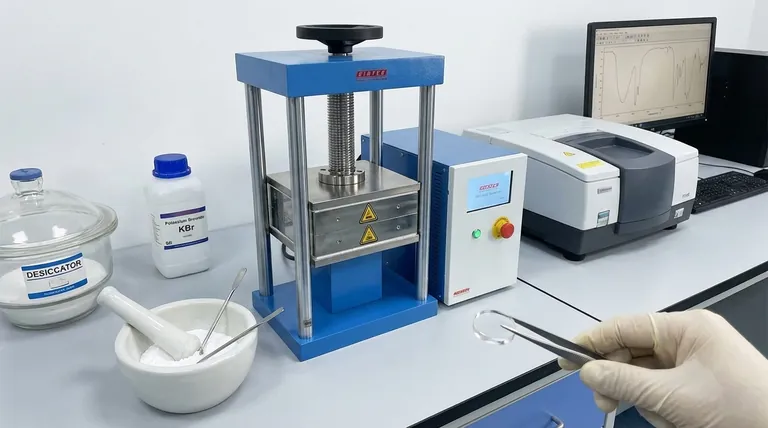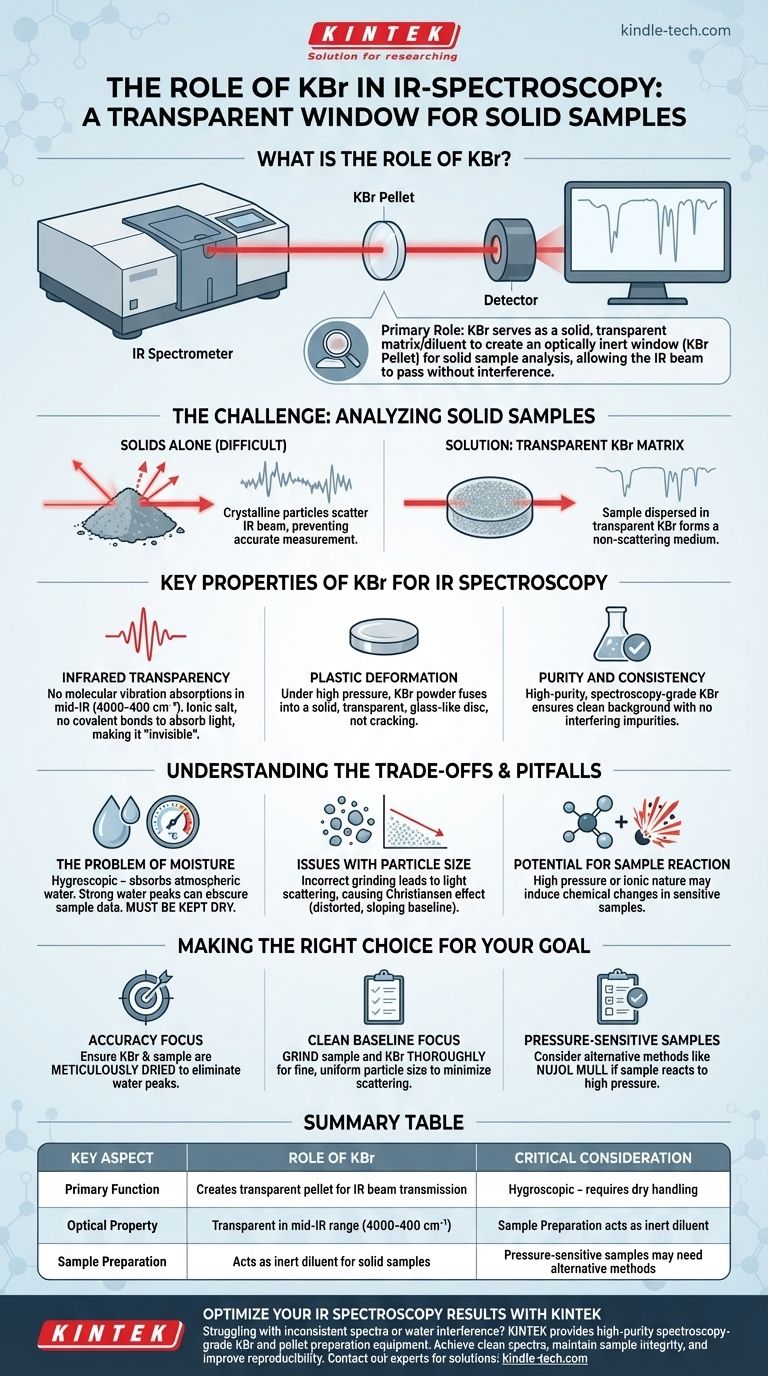في مطيافية الأشعة تحت الحمراء (IR)، يعمل بروميد البوتاسيوم (KBr) كمصفوفة صلبة أو مخفف يستخدم لحمل عينة صلبة للتحليل. يتمثل دوره الأساسي في إنشاء نافذة صغيرة وشفافة - تسمى قرص KBr - يمكن أن يمر من خلالها شعاع الجهاز تحت الحمراء. يتم طحن العينة الصلبة جيدًا ومزجها بمسحوق KBr النقي، ثم ضغطها تحت ضغط عالٍ لتشكيل هذا القرص.
الوظيفة الأساسية لـ KBr هي توفير بيئة خاملة بصريًا للعينة الصلبة. نظرًا لأن KBr شفاف للإشعاع تحت الأحمر، فإنه يسمح للمطياف بقياس طيف الامتصاص للعينة نفسها دون تداخل من المصفوفة المحيطة.

التحدي الأساسي: تحليل العينات الصلبة
تعتمد مطيافية الأشعة تحت الحمراء على قياس كيفية امتصاص الروابط الكيميائية في العينة لضوء الأشعة تحت الحمراء. لكي يعمل هذا، يجب أن يكون شعاع الأشعة تحت الحمراء قادرًا على المرور عبر العينة بوضوح.
لماذا تعتبر المواد الصلبة صعبة
على عكس السوائل أو الغازات التي يمكن وضعها في خلايا شفافة بسيطة، لا يمكن تحليل مسحوق صلب مباشرة. ستقوم الجسيمات البلورية بتشتيت شعاع الأشعة تحت الحمراء، مما يمنع قياس امتصاص دقيق.
الحل: مصفوفة شفافة
للتغلب على هذا، يتم تشتيت العينة الصلبة بالتساوي داخل وسط لا يتداخل مع القياس. يجب أن يكون هذا الوسط شفافًا في منطقة الأشعة تحت الحمراء ويشكل وسطًا صلبًا وغير مشتت عند تحضيره. هذا هو بالضبط الدور الذي يلعبه KBr.
الخصائص الرئيسية لـ KBr لمطيافية الأشعة تحت الحمراء
KBr ليس المادة الوحيدة التي يمكن استخدامها، ولكنه الأكثر شيوعًا بسبب مزيجه المثالي من الخصائص الفيزيائية والبصرية.
الشفافية تحت الحمراء
الخاصية الأكثر أهمية لـ KBr هي عدم وجود اهتزازات جزيئية له في نطاق الأشعة تحت الحمراء المتوسطة (4000-400 سم⁻¹). نظرًا لأنه ملح أيوني بسيط، فإنه لا يحتوي على روابط تساهمية تمتص ضوء الأشعة تحت الحمراء في هذا النطاق، مما يجعله غير مرئي فعليًا للمطياف ويخلق نافذة واضحة لطيف العينة.
التشوه اللدن
عند تعرضه لضغط عالٍ (بمقدار أطنان لكل بوصة مربعة)، يمتلك مسحوق KBr خاصية فريدة تتمثل في التدفق اللدن. هذا يعني أنه يندمج معًا لتشكيل قرص صلب وشفاف وشبيه بالزجاج بدلاً من التشقق أو التفتت.
النقاء والاتساق
يتوفر KBr عالي النقاء ودرجة المطيافية بسهولة. يضمن هذا عدم وجود شوائب قد تُدخل قممًا غير مرغوب فيها في الطيف، مما يوفر خلفية نظيفة وموثوقة.
فهم المفاضلات والمزالق
على الرغم من أن تقنية قرص KBr قوية، إلا أنها ليست خالية من التحديات. التحضير المناسب ضروري للحصول على طيف عالي الجودة.
مشكلة الرطوبة
KBr مستَرطِب، مما يعني أنه يمتص الماء بسهولة من الغلاف الجوي. يحتوي الماء على نطاقات امتصاص قوية وواسعة جدًا للأشعة تحت الحمراء يمكن أن تحجب بسهولة القمم المهمة من العينة. لذلك، يجب الحفاظ على KBr جافًا تمامًا، غالبًا عن طريق تخزينه في مجفف أو فرن.
مشاكل حجم الجسيمات
إذا لم يتم طحن العينة بدقة كافية أو مزجها بشكل متجانس مع KBr، فإن جسيماتها ستشتت ضوء الأشعة تحت الحمراء. يؤدي هذا إلى خط أساس مائل ومشوّه وجودة طيف منخفضة، وهي مشكلة تُعرف باسم تأثير كريستيانسن.
احتمالية تفاعل العينة
يمكن للضغط العالي للغاية المستخدم لتشكيل القرص أن يحفز أحيانًا تفاعلًا كيميائيًا أو تغييرًا في الطور في العينة. بالإضافة إلى ذلك، يمكن للطبيعة الأيونية لـ KBr أن تتفاعل مع أنواع معينة من العينات، مما يغير أطيافها.
اتخاذ الخيار الصحيح لهدفك
التقنية الصحيحة أمر بالغ الأهمية عند استخدام KBr لضمان دقة نتائجك وقابليتها للتكرار.
- إذا كان تركيزك الأساسي هو الدقة: تأكد من تجفيف كل من KBr والعينة بدقة قبل التحضير للتخلص من قمم الماء المتداخلة.
- إذا كان تركيزك الأساسي هو خط أساس نظيف: اطحن العينة و KBr معًا جيدًا لتحقيق حجم جسيمات دقيق وموحد، مما يقلل من تشتت الضوء.
- إذا كنت تشك في أن عينتك حساسة للضغط: فكر في طريقة بديلة لأخذ العينات الصلبة، مثل تحضير معجون نوجول (Nujol mull)، الذي لا يتطلب ضغطًا عاليًا.
في النهاية، يعد فهم دور KBr كنافذة بصرية خاملة هو المفتاح لإتقان هذه التقنية الطيفية الأساسية.
جدول ملخص:
| الجانب الرئيسي | دور KBr |
|---|---|
| الوظيفة الأساسية | يخلق قرصًا شفافًا لنقل شعاع الأشعة تحت الحمراء |
| الخاصية البصرية | شفاف في نطاق الأشعة تحت الحمراء المتوسطة (4000-400 سم⁻¹) |
| تحضير العينة | يعمل كمخفف خامل للعينات الصلبة |
| الاعتبار الحاسم | مستَرطِب - يتطلب التعامل الجاف |
| حالات الاستخدام البديلة | قد تحتاج العينات الحساسة للضغط إلى طرق بديلة |
حسّن نتائج مطيافية الأشعة تحت الحمراء الخاصة بك مع KINTEK
هل تعاني من أطياف أشعة تحت حمراء غير متسقة أو تداخل الماء في تحليل العينات الصلبة لديك؟ تتخصص KINTEK في معدات ومواد المختبرات عالية النقاء التي تضمن نتائج طيفية دقيقة.
تساعدك مواد KBr عالية النقاء الخاصة بنا ومعدات تحضير الأقراص على:
- تحقيق أطياف نظيفة وخالية من التداخل مع شفافية مثالية
- الحفاظ على سلامة العينة من خلال حلول التجفيف والتعامل المناسبة
- تحسين القابلية للتكرار باستخدام مواد متسقة وعالية الجودة
سواء كنت تقوم بتحليل المستحضرات الصيدلانية أو البوليمرات أو عينات الأبحاث، توفر KINTEK معدات المختبرات والمواد الاستهلاكية الموثوقة التي يحتاجها مختبرك لإجراء مطيافية دقيقة للأشعة تحت الحمراء.
اتصل بخبرائنا اليوم لمناقشة متطلبات تطبيقك المحددة واكتشاف كيف يمكن لحلولنا تعزيز قدراتك التحليلية!
دليل مرئي

المنتجات ذات الصلة
- مكبس كهربائي معملي هيدروليكي مقسم لتشكيل الأقراص
- مكبس هيدروليكي أوتوماتيكي للمختبرات لضغط حبيبات XRF و KBR
- دليل المختبر مكبس هيدروليكي للأقراص للاستخدام المخبري
- مكبس حبيبات KBR 2 طن
- مكبس هيدروليكي معملي آلة ضغط الأقراص للمختبرات صندوق القفازات
يسأل الناس أيضًا
- ما هي طريقة قرص بروميد البوتاسيوم (KBr)؟ دليل شامل لإعداد العينات في مطيافية الأشعة تحت الحمراء
- ما هي المكابس الهيدروليكية لإعداد العينات؟ أنشئ أقراصًا متسقة لتحليل موثوق
- كيف يؤثر الضغط على النظام الهيدروليكي؟ إتقان القوة والكفاءة والحرارة
- ما هو أقصى ضغط يمكن أن يولده مكبس هيدروليكي؟ من 1 طن إلى أكثر من 75,000 طن من القوة
- كم تبلغ القوة التي يمكن لمكبس هيدروليكي أن يبذلها؟ فهم قوته الهائلة وحدود تصميمه.



















